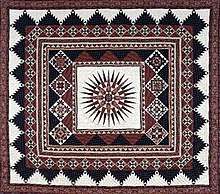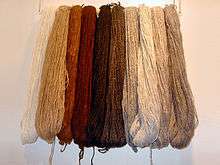Quilting
Quilting is the term given to the process of joining a minimum of three layers of fabric together either through stitching manually by hand using a needle and thread, or mechanically with a sewing machine or specialised longarm quilting system. An array of stitches is passed through all layers of the fabric to create a three dimensional padded surface. The three layers are typically referred to as the top fabric or quilt top, batting or insulating material and the backing.
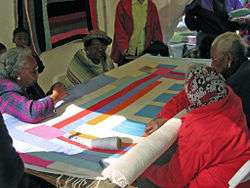
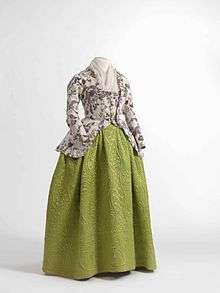
Quilting varies from a purely functional fabric joinery technique to highly elaborate, decorative three dimensional surface treatments. A wide variety of textile products are traditionally associated with quilting that includes bed coverings, soft home furnishings, garments and costumes, wall hangings, artistic objects and cultural artefacts.
A wide range of effects can be employed by the quilter that contribute to the final surface quality and utility of the quilted material. The quilter controls these effects through the manipulation of elements such as material type and thickness, stitch length and style, pattern design, piecing and cutting. Two dimensional effects such as optical illusions can be achieved through aesthetic choices regarding colour, texture and print. Three dimensional and sculptural components of quilted material can be manipulated and enhanced with further embellishment which may include appliqué, embroidery techniques such as shisha mirror work, and the inclusion of other objects or elements such as pearls, beads, buttons, sequins. Some quilters dye or create their own fabrics. In contemporary artistic quilting, new and experimental materials such as plastics, paper, naturally occurring fibres and plants amongst a diverse array of other materials have been used.
Quilting can be considered one of the first examples of upcycling, as it has historically made extensive use of remnants and offcuts for the creation of new products.
History
Early quilting
The origin of the term 'quilt' is linked to the Latin word culcita, meaning a bolster or cushion. Usage of the term seems to have first been used in England in the 13th century.[1] However the sewing techniques of piecing, appliqué, and quilting have been used for clothing and furnishings in diverse parts of the world for several millennia and a wide range of quilting styles and techniques have uniquely evolved around the globe.
The earliest known quilted garment is depicted on the carved ivory figure of a Pharaoh dating from the ancient Egyptian First Dynasty (c. 3400 BC). In 1924 archaeologists discovered a quilted floor covering in Mongolia, estimated to date between 100 BC and 200 AD.
In Europe, quilting has been part of the needlework tradition from about the fifth century, with early objects containing Egyptian cotton, which may indicate that Egyptian and Mediterranean trade provided a conduit for the technique. However, quilted objects were relatively rare in Europe until approximately the twelfth century, when quilted bedding and other items appeared after the return of the Crusaders from the Middle East. The medieval quilted gambeson, aketon and arming doublet[2] were garments worn under or instead of armor of maille or plate armor. These developed into the later quilted doublet worn as part of fashionable European male clothing from the fourteenth to seventeenth century. The earliest known surviving European bed quilt is from late-fourteenth-century Sicily: the Tristan quilt made of linen and padded with wool. The blocks across the center are scenes from the legend of Tristan. The quilt is 320 × 287 cm (126 × 113 in)[3] and is in the Victoria and Albert Museum in London.[4]
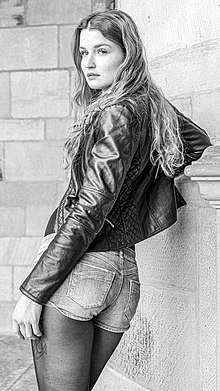
The word quilt comes from the Latin culcita meaning a stuffed sack, but it came into the English language from the French word cuilte.[4]
American quilts
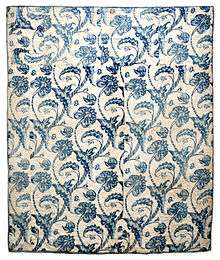
In American Colonial times, quilts were predominantly whole-cloth quilts—a single piece of fabric layered with batting and backing held together with fine needlework quilting. Broderie perse quilts were popular during this time and the majority of pierced or appliqued quilts made during the 1170–1800 period were medallion-style quilts (quilts with a central ornamental panel and one or more borders).[5] Patchwork quilting in America dates to the 1770s, the decade the United States gained its independence from England. These late-eighteenth- and nineteenth-century patchwork quilts often mixed wool, silk, linen, and cotton in the same piece, as well as mixing large-scale (often chintz) and small-scale (often calico) patterns.[6] Some antique quilts made in North America have worn-out blankets or older quilts as the internal batting layer, quilted between new layers of fabric and thereby extending the usefulness of old material.
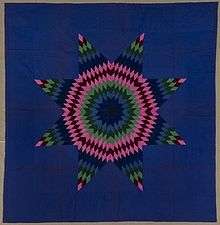
During American pioneer days, foundation piecing became popular. Paper was cut into shapes and used as a pattern; each individual piece of cut fabric was basted around the paper pattern. Paper was a scarce commodity in the early American west so women would save letters from home, postcards, newspaper clippings, and catalogs to use as patterns. The paper not only served as a pattern but as an insulator. The paper found between the old quilts has become a primary source of information about pioneer life.
Quilts made without any insulation or batting were referred to as summer quilts. They were not made for warmth, only to keep the chill off during cooler summer evenings.
African-American quilts
There is a long tradition of African-American quilting beginning with quilts made by slaves, both for themselves and for their owners. The style of these quilts was determined largely by time period and region, rather than race, and the documented slave-made quilts generally resemble those made by white women in their region.[7] After 1865 and the end of slavery in the United States, African-Americans began to develop their own distinctive style of quilting. Harriet Powers, a slave-born African American woman, made two famous story quilts.[8] She was just one of the many African-American quilters who contributed to the evolution of quilting. The first nationwide recognition of African-American quilt-making came when the Gee's Bend quilting community was celebrated in an exhibition that opened in 2002 and traveled to many museums, including the Smithsonian.[9] Gee's Bend is a small, isolated community of African-Americans in southern Alabama with a quilt-making tradition that goes back several generations[10][11] and is characterized by pattern improvisation, multiple patterning, bright and contrasting colors, visual motion, and a lack of rules.[12] The contributions made by Harriet Powers and other quilters of Gee's Bend, Alabama have been recognized by the US Postal Service with a series of stamps.[13] The communal nature of the quilting process (and how it can bring together women of varied races and backgrounds) was honored in the series of stamps.
Beginning with the children's story Sweet Clara and the Freedom Quilt (1989) a legend has grown that slaves used quilts as a means to share and transmit secret messages to escape slavery and travel the Underground Railroad. Consensus among historians is that there is no sound basis for this belief, and no documented mention among the thousands of slave narratives or other contemporary records.[14][15][16]
Amish quilts
Another American group to develop a distinct style of quilting were the Amish. Typically, these quilts use only solid fabrics, are pieced from geometric shapes, do not contain appliqué, and construction is simple (corners are butted, rather than mitered, for instance) and done entirely by hand. Amish quilters also tend to use simple patterns: Lancaster County Amish are known for their Diamond-in-a-Square and Bars patterns, while other communities use patterns such as Brick, Streak of Lightning, Chinese Coins, and Log Cabins, and midwestern communities are known for their repeating block patterns. Borders and color choice also vary by community. For example, Lancaster quilts feature wide borders with lavish quilting, while Midwestern quilts feature narrower borders to balance the fancier piecing.[17]
Native American quilts
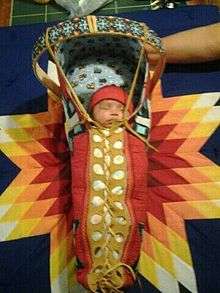
Some Native Americans are thought to have learned quilting through observation of white settlers; others learned it from missionaries who taught quilting to Native American women along with other homemaking skills. Native American women quickly developed their own unique style, the Lone Star design (also called the Star of Bethlehem), a variation on Morning Star designs that had been featured on Native American clothing and other items for centuries. These quilts often featured floral appliqué framing the star design. Star quilts have become an important part of many Plains Indian ceremonies, replacing buffalo robes traditionally given away at births, marriages, tribal elections, and other ceremonies.[18] Pictorial quilts, created with appliqué, were also common.[8]
Another distinctive style of Native American quilting is Seminole piecing, created by Seminoles living in the Florida Everglades. The style evolved out a need for cloth (the closest town was often a week's journey away). Women would make strips of sewing the remnants of fabric rolls together, then sew these into larger pieces to make clothing. Eventually the style began to be used not just for clothing but for quilts as well. In 1900, with the introduction of sewing machines and readily available fabric in Seminole communities, the patterns became much more elaborate and the style continues to be in use today, both by Seminole women and by others who have copied and adapted their designs and techniques.[11]
Hawaiian quilting
"Hawaiian quilting was well established by the beginning of the twentieth century. Hawaiian women learned to quilt from the wives of missionaries from New England in the 1820s. Though they learned both pieced work and applique, by the 1870s they had adapted applique techniques to create a uniquely Hawaiian mode of expression. The classic Hawaiian quilt design is a large, bold, curvilinear appliqué pattern that covers much of the surface of the quilt, with the symmetrical design cut from only one piece of fabric."[19]
South Asian quilting
There are two primary forms of quilting that originate in South Asia: Nakshi Kantha and Ralli. Nakshi Kantha quilts originated in India and are typically made of scraps and worn-out fabric stitched together with old sari threads using kantha embroidery stitches. "The layers of cloth were spread on the ground, held in place with weights at the edges, and sewn together with rows of large basting stitches. The cloth was then folded and worked on whenever there was time."[11] The first recorded kantha are more than 500 years old.
Ralli quilts are traditionally made in Pakistan, western India, and the surrounding area. They are made by every sector of society including Hindu and Muslim women, women of different castes, and women from different towns or villages or tribes with the colors and designs varying among these groups. The name comes from ralanna, a word meaning to mix or connect. Quilts tops were designed and pieced by one woman using scraps of hand-dyed cotton. This cotton often comes from old dresses or shawls. Once pieced, the quilt top is placed on a reed mat with the other layers and sewn together using thick, colored thread in straight parallel lines by members of the designer's family and community.[11]
Swedish quilting
Quilting originated in Sweden in the fifteenth century with heavily stitched and appliquéd quilts made for the very wealthy. These quilts, created from silk, wool, and felt, were intended to be both decorative and functional and were found in churches and in the homes of nobility. Imported cotton first appeared in Sweden in 1870, and began to appear in Swedish quilts soon after along with scraps of wool, silk, and linen. As the availability of cotton increased and its price went down, quilting became widespread among all classes of Swedish society. Wealthier quilters used wool batting while others used linen scraps, rags, or paper mixed with animal hair. In general, these quilts were simple and narrow, made by both men and women. The biggest influence on Swedish quilting in this time period is thought to have come from America as Swedish immigrants to the United States returned to their home country when conditions there improved.[11]
Art quilting
During the late 20th century, art quilts became popular for their aesthetic and artistic qualities rather than for functionality as they are displayed on a wall or table rather than being used on a bed.. "It is believed that decorative quilting came to Europe and Asia during the Crusades (A.D. 1100–1300), a likely idea because textile arts were more developed in China and India than in the West."[20]
Modern quilting
In the early 21st century, modern quilting became a more prominent area of quilting. Modern quilting follows a distinct aesthetic style which draws on inspiration from modern style in architecture, art, and design using traditional quilt making techniques.[21] Modern quilts are different from art quilts in that they are made to be used.[22] Modern quilts are also influenced by the Quilters of Gee's Bend, Amish quilts, Nancy Crow, Denyse Schmidt, Gwen Marston, Yoshiko Jinzenji, Bill Kerr and Weeks Ringle.[23]
The Modern Quilt Guild has attempted to define modern quilting. The characteristics of a modern quilt may include: the use of bold colors and prints, high contrast and graphic areas of solid color, improvisational piecing, minimalism, expansive negative space, and alternate grid work.[24]
The Modern Quilt Guild, a non-profit corporation, with 14,000 members in more than 200 members guilds in 39 countries, fosters modern quilting via local guilds, workshops, webinars, and Quiltcon—an annual modern quilting conference and convention. The founding Modern Quilt Guild formed in October 2009 in Los Angeles.[25]
QuiltCon features a quilt show with 400+ quilts, quilt vendors, lectures, and quilting workshops and classes. The first QuiltCon was February 21–24, 2013 in Austin, TX.[26] QuiltCon 2020 will be held in Austin, Texas, February 20–23, 2020 and will feature 400 juried modern quilts from quilters around the world.[27]
Quilting in fashion and design

Unusual quilting designs have increasingly become popular as decorative textiles. As industrial sewing technology has become more precise and flexible, quilting using exotic fabrics and embroidery began to appear in home furnishings in the early 21st century.
Quilt blocks
The quilt block is traditionally a sub-unit composed of several pieces of fabric sewn together. The quilt blocks are repeated, or sometimes alternated with plain blocks, to form the overall design of a quilt. Barbara Brackman has documented over 4000 different quilt block patterns from the early 1830s to the 1970s in the Encyclopedia Of Pieced Quilt Patterns.[28] Some of the simpler designs for quilt blocks include the Nine-Patch, Shoo Fly, Churn Dash, and the Prairie Queen.
Most geometric quilt block designs fit into a "grid," the number of squares a pattern block is divided into. The five categories into which most square patterns fall are Four Patch, Nine Patch, Five-Patch, Seven-Patch, and Eight-Pointed Star. Each block can be subdivided into multiples: a Four-Patch can be constructed of 16 or 64 squares, for example.[29]
A simple Nine Patch is made by sewing five patterned or dark pieces (patches) to four light square pieces in alternating order. These nine sewn squares make one block.[30]
The Shoo Fly varies from this Nine Patch by dividing each of the four corner pieces into a light and dark triangle.[31]
Another variation develops when one square piece is divided into two equal rectangles in the basic Nine Patch design. The Churn Dash block combines the triangles and rectangle to expand the Nine Patch.[32]
The Prairie Queen block combines two large scale triangles in the corner section with the middle section using four squares. The center piece is one full size square. Each of the nine sections does have the same overall measurement and fits together.[4]
The number of patterns possible by subdividing Four-, Five-, Seven-, Nine-Patches and Eight-Pointed Stars and using triangles instead of squares in the small subdivisions is almost endless.
Types and equipment
Many types of quilting exist today. The two most widely used are hand-quilting and machine quilting.
Hand quilting is the process of using a needle and thread to sew a running stitch by hand across the entire area to be quilted. This binds the layers together. A quilting frame or hoop is often used to assist in holding the piece being quilted off the quilter's lap. A quilter can make one stitch at a time by first driving the needle through the fabric from the right side, then pushing it back up through the material from the wrong side to complete the stitch; this is called a stab stitch.[33] Another option is called a rocking stitch, where the quilter has one hand, usually with a finger wearing a thimble, on top of the quilt, while the other hand is located beneath the piece to push the needle back up.[34] A third option is called "loading the needle" and involves doing four or more stitches before pulling the needle through the cloth. Hand quilting is still practiced by the Amish and Mennonites within the United States and Canada, and is enjoying a resurgence worldwide.
Machine quilting is the process of using a home sewing machine or a longarm machine to sew the layers together. With the home sewing machine, the layers are tacked together before quilting. This involves laying the top, batting, and backing out on a flat surface and either pinning (using large safety pins) or tacking the layers together.[35] Longarm quilting involves placing the layers to be quilted on a special frame. The frame has bars on which the layers are rolled, keeping these together without the need for tacking or pinning. These frames are used with a professional sewing machine mounted on a platform. The platform rides along tracks so that the machine can be moved across the layers on the frame. A longarm machine is moved across the fabric. In contrast, the fabric is moved through a home sewing machine.
Tying is another technique of fastening the three layers together. This is done primarily on quilts that are made to be used and are needed quickly. The process of tying the quilt is done with yarns or multiple strands of thread. Square knots are used to finish off the ties so that the quilt may be washed and used without fear of the knots coming undone.[36] This technique is commonly called "tacking." In the Midwest, tacked bed covers are referred to as comforters.
Quilting is now taught in some American schools.[37] It is also taught at senior centers around the U.S., but quilters of all ages attend classes. These forms of workshops or classes are also available in other countries in guilds and community colleges.
Contemporary quilters use a wide range of quilting designs and styles, from ancient and ethnic to post-modern futuristic patterns. There is no one single school or style that dominates the quilt-making world. Regardless of skill level, all quilters know the importance of having the right tools when quilting. Having the right tools increases the fluid process of making a quilt and can even be improved over time with practice. Having the right tools will maximize efficiency and make the quilting experience one to remember. Below is a list of the different tools and tips that can be used to make a quilt by hand or machine:[38][39]
A good quality sewing machine is a helpful addition to the process of piecing together a quilt top. Some also use a home sewing machine for quilting together the layers of the quilt, as well as binding the final product. While almost all home sewing machines can be used to quilt layers together, having a wide throat, the space to the right of the needle mechanism, is very helpful because it is easier to manipulate a bulky quilt through the machine when the throat is both high and long. It is important to understand how your particular model functions in order to select the correct settings, thread the needle and bobbin, and operate the machine. Here is a handy guide on using a machine.
- Fabric Markers or Ruler
When making a quilt it is important to mark the fabric that you are cutting in order to have some kind of guidance when cutting the fabric, or you could use a quilting ruler and rotary cutter. When marking the fabric it is advised that you use a fabric marker, which is a marker that washes out when the quilt is washed or will fade away after repeated washes.[38]
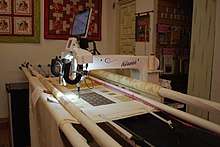
- Longarm quilting Machines
The longarm quilting machine makes it easier to make larger quilts because of the extended arm that is used. Being able to leverage the larger machine and not having to hold the material that is being used while quilting helps the process move along much faster and makes it easier on the quilter.[38] Some quilt shops offer longarm services, where one can pay for their project to be quilted and in some cases, bound as well.
- Machine Quilting Needles
When quilting, one of the most important tools that is used is the needle. Whether you are quilting by hand or by machine, the needle that is being used is critical to the final result. Using the wrong needle can lead to puckering, bumps, or even the material being torn. Machine quilting needs a sharp needle to easily pierce the three-part quilt sandwich and properly sew together the quilt top, batting and backing.[38]
- Hand Quilting Needles
The traditional needles used for quilting are called betweens and are generally smaller and stronger than normal sewing needles. They have a very small eye which prevents any extra bump at the head of the needles when you are pulling through the thread.[38]
- Pins and Thimbles
Understanding how pins and thimbles work is also very important in the process of making quilts. Many different combinations of pinning can be used in order get similar results and the exciting part is figuring out existing combinations as well as coming up with new ones. Thimbles are not required but are good for keeping fingers safe.[38]
- Threads
Choosing the right types of threads for a quilt can be difficult and beginners may need some assistance from an expert or more advanced quilter. The color, composition, and type of thread that is used will have a pivotal role in the outcome of the final quilt.[38]
- Rotary Cutters and Boards
What a quilter uses to cut the fabric is a vital step in the quilting process. It is very important each piece is perfectly aligned in order to prevent an uneven or sloppy appearance and to prevent rework. Rotary cutters revolutionized quiltmaking when they appeared in the late 1970s. A rotary cutter offers even the shakiest of hands the ability to produce perfect, even slices and minimizes the chance of error.[40]
- Quilting Templates/Patterns
Quilts can have many different templates or patterns and they can have a large impact on the final result. There are a number of mediums that can be used and depending on the usage, size, and style they will give your quilt a varied look. Templates are generally considered the basis of the structure of the quilt, like a blueprint for a house. If used properly it can help quilters produce a quilt of their liking and give them a sense of satisfaction and vision for future quilts they want to make.[39]
Specialty styles
- Foundation piecing – also known as paper-piecing – sewing pieces of fabric onto a temporary or permanent foundation
- Shadow or echo quilting – Hawaiian quilting, where quilting is done around an appliquéd piece on the quilt top, then the quilting is echoed again and again around the previous quilting line.
- Ralli quilting – Pakistani and Indian quilting, often associated with the Sindh (Pakistan) and Gujarat (India) regions.
- Sashiko stitching – Basic running stitch worked in heavy, white cotton thread usually on dark indigo colored fabric. It was originally used by the working classes to stitch layers together for warmth.[41]
- Trapunto quilting – stuffed quilting, often associated with Italy.
- Machine trapunto quilting – a process of using water-soluble thread and an extra layer of batting to achieve trapunto design and then sandwiching the quilt and re-sewing the design with regular cotton thread.
- Shadow trapunto – This involves quilting a design in fine lawn and filling some of the spaces in the pattern with small lengths of colored wool.
- Tivaevae or tifaifai – A distinct art from the Cook Islands.
- Watercolor quilting – A sophisticated form of scrap quilting whereby uniform sizes of various prints are arranged and sewn to create a picture or design. See also Colorwash.
- Thread art – A custom style of sewing where thread is layered to create the picture on the quilt.
References
- "V&A · An introduction to quilting and patchwork". Victoria and Albert Museum. Retrieved 2020-06-10.
- Archived December 28, 2011, at the Wayback Machine
- The Tristan Quilt in the collections of the Victoria and Albert Museum, London. Accessed 5-2-2010
- Johnson, Julie. "History of Quilting". Center for Great Plain Studies. Emporia State University. Retrieved 31 January 2014.
- Hargrave, Harriet and Carrie (2015). Quilter's Academy Vol. 5 – Masters Year. Concord: C&T Publishing. p. 6. ISBN 978-1-57120-792-0.
- Brackman, Barbara (2004). America's Printed Fabrics: 1770–1890. Concord: C&T Publishing. pp. 6–7. ISBN 1-57120-255-2.
- Brackman, Barbara (2006). Facts & Fabrications: Unraveling the History of Quilts & Slavery. Concord: C&T Publishing. p. 15. ISBN 978-1-57120-364-9.
- Eisenmann, Deanne (2014). Blooming Patchwork. Kansas City, MO: Kansas City Star Books. p. 12. ISBN 978-1-61169-144-3.
- "History, Travel, Arts, Science, People, Places – Smithsonian". smithsonianmag.com.
- Curran, Maris (13 November 2018). "Opinion: The Master Quilters of Gee's Bend, AL". New York Times. Retrieved 24 November 2018.
- Ellis, Cassandra (2014). World of Quilts. Concord, CA: C&T Publishing. pp. 10–150. ISBN 978-1-60705-953-0.
- Heffley, Scott (2007). Bold Improvisation. Kansas City, MO: Kansas City Star Books. pp. 4–10. ISBN 978-1-933466-25-5.
- "Quilts of Gee's Bend commemorative postage stamps". Archived from the original on June 6, 2011.
- "Underground Railroad Quilts: Documentary Evidence is Missing". www.historyofquilts.com.
- "Archived copy". Archived from the original on February 4, 2013. Retrieved January 23, 2013.CS1 maint: archived copy as title (link)
- "The Jacob's Ladder Pattern Became the Underground Railroad Quilt". www.womenfolk.com.
- Koolish, Lynn (2013). Amish Quilts–The Adventure Continues. Concord: C&T Publishing. pp. 9–10. ISBN 978-1-60705-791-8.
- Murphy, Mary (Autumn 2008). "Montana Quilts and Quiltmakers: A History of Work and Beauty". Montana The Magazine of Western History. 58 (3): 39–40. JSTOR 25485734.
- "Quilts". The Encyclopedia of American Folk Art. Ann Arbor, Michigan: Florence Taylor and Francis. 2003. ISBN 978-0203644485.
- Bial, Raymond (1996). With Needle and Thread. Boston; New York: Houghton Mifflin Company. pp. 18.
- Grant, Heather (September–October 2012). "The Birth of Modern Quilting". McCall's Quilting Magazine: 56–58.
- "What is Modern Quilting?". The Modern Quilt Guild. Retrieved 2017-11-29.
- May, Rachel (2014). Quilting with a Modern Slant. North Adams, MA: Storey Publishing. pp. 7, 14, 18, 27, 51, 59, 66. ISBN 978-1-61212-063-8.
- "Modern Quilting". www.themodernquiltguild.com.
- "About the Modern Quilt Guild". www.themodernquiltguild.com.
- "QuiltCon". February 20, 2012.
- "About QuiltCon". QuiltCon.
- Brackman, Barbara (1993). Encyclopedia of Pieced Quilt Patterns. Paducah, KY: American Quilter's Society. p. 552. ISBN 978-0891458159.
- Beyer, Jinny (1979). Patchwork Patterns. McLean, VA: EPM Publications Inc. pp. 8–9. ISBN 0-914440-27-6.
- The New Quick & Easy Block Tool!. Concord, CA: C&T Publishing. 2016. p. 83. ISBN 978-1-61745-231-4.
- The New Quick & Easy Block Tool!. Concord, CA: C&T Publishing. 2016. p. 95. ISBN 978-1-61745-231-4.
- The New Quick & Easy Block Tool!. Concord, CA: C&T Publishing. 2016. p. 34. ISBN 978-1-61745-231-4.
- "Stab Stitch Quilting". Barbara Robson.
- Anderson, Alex (2015). All Things Quilting with Alex Anderson. Concord, CA: C&T Publishing. p. 132. ISBN 978-1-60705-856-4.
- Anderson, Alex (2015). All Things Quilting with Alex Anderson. Concord, CA: C&T Publishing. pp. 129–130. ISBN 978-1-60705-856-4.
- Anderson, Alex (2015). All Things Quilting with Alex Anderson. Concord, CA: C&T Publishing. p. 154. ISBN 978-1-60705-856-4.
- "MA – Textile History/Quilt Studies Distance Learning Option III | College of Education and Human Sciences". cehs.unl.edu. Retrieved 2019-06-16.
- "Quilting 101 – Quilt making tips and resources". Quilting. Retrieved 28 January 2014.
- Cox, Meg (May 9, 2013). "'Modern Quilters' Stress Simplicity, Edgy Subjects". The Wall Street Journal. Retrieved 28 January 2014.
- Anderson, Alex (2015). All Things Quilting with Alex Anderson. Concord, CA: C&T Publishing. p. 36. ISBN 978-1-60705-856-4.
- Sharon Pederson,(2005). Sensational Sashiko, Japanese Applique and Quilting by Machine. p.5, Martingale & Co., Woodinville, WA
Further reading
- Bristow, Lora J. "Women’s work: social relations of quilting." (Thesis, Humboldt State University, 2013. online
- Brown, Elsa Barkley. "African-American women's quilting." Signs: Journal of Women in Culture and Society 14.4 (1989): 921-929. online
- Colby, Averil. Quilting. (Charles Scribner's Sons, 1971).
- Gillespie, Spike. Quilts around the world: The story of quilting from Alabama to Zimbabwe (Voyageur Press, 2010).
- Kiracofe, Roderick, and Mary Elizabeth Johnson Huff. The American quilt: A history of cloth and comfort, 1750-1950 (1993).
- Torsney, Cheryl B., and Judy Elsley, eds. Quilt Culture: Tracing the Pattern. (U of Missouri Press, 1994.)
- Turner, Patricia A. Crafted Lives: Stories and Studies of African American Quilters (U of Mississippi Press, 2009).
- Yep, Gust A. 2007. “The Politics of Loss and Its Remains in Common Threads: Stories from the Quilt.” Rhetoric & Public Affairs 10(4):681–700.
External links
| Wikimedia Commons has media related to Quilting. |
